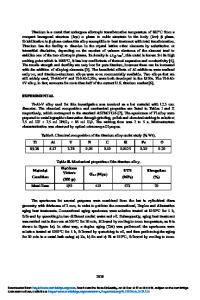Formation of the Microstructure and Mechanical Properties of VT22 Titanium Alloy Under Nonequilibrium Conditions of Rapi
- PDF / 2,944,449 Bytes
- 7 Pages / 594 x 792 pts Page_size
- 58 Downloads / 315 Views
FORMATION OF THE MICROSTRUCTURE AND MECHANICAL PROPERTIES OF VT22 TITANIUM ALLOY UNDER NONEQUILIBRIUM CONDITIONS OF RAPID HEAT TREATMENT О. М. Ivasyshyn,1 P. E. Markovs’kyi,1, 2 and I. М. Havrysh1, 3
UDC 669.225
We study specific features of the formation of microstructure and a complex of mechanical properties of VT22 high-strength titanium alloy in the process of rapid thermal treatment depending on conditions of cooling in the course of hardening. It is shown that the procedure of quenching in water guarantees better results of thermal hardening in the course of rapid thermal treatment due to the formation of a larger number of point defects and the decomposition of the metastable β -phase during aging accompanied by the formation of intermediate ω - and α ′′(α ′ ) -phases. The main advantage of rapid heating over the heating in furnace is connected with the possibility of transformation of the entire volume of the alloy into the metastable β -phase without catastrophic growth of grains. This enables one to significantly increase the strength of alloy (up to 1445 MPa) with preservation of sufficiently high levels of the characteristics of plasticity and impact toughness. Keywords: VT22 titanium alloy, hardening rapid thermal treatment, cooling rate, aging, mechanical properties.
It is customary to use VT22 alloy for the production of critical massive products of the aerospace machine building for which, in the course of thermal hardening, it is possible to apply the procedure of quenching (cooling) in air guaranteeing its ultimate strength of up to 1150 МРа [1, 2]. The development of contemporary aircrafts requires that some articles, e.g., the components of detachable joints, must have much higher levels of strength (not lower than 1350 MPa). In order to create high-strength VT22 alloy as a result of standard heat treatment, it is necessary to quench the semifinished items in water after heating in a furnace (treatment for the solid β -solution) [3]. This is connected with the fact that, just in the course of rapid cooling, we observe the formation of high density of vacancy-type point defects in the metastable β -phase. In the course of subsequent aging, these defects promote the formation of the hardening α -phase, which is finer and more uniformly distributed over the volume of the grains [4]. In addition, as shown in [4, 5], the application of rapid heat treatment (RHT) under the conditions far from equilibrium enables one to significantly improve the characteristics of strength as compared with the standard treatment in the furnace. This is explained by the fact that, in the course of this procedure, the entire volume of the alloy participates in thermal hardening and, hence, the size of β -grains remains minimal. Moreover, the chemical inhomogeneity of the high-temperature β -phase leads to an additional diminution of the products of its decomposition in the course of subsequent cooling and aging [6]. However, under the nonequilibrium conditions of RHT, the critical points of phase transformations shift
Data Loading...











